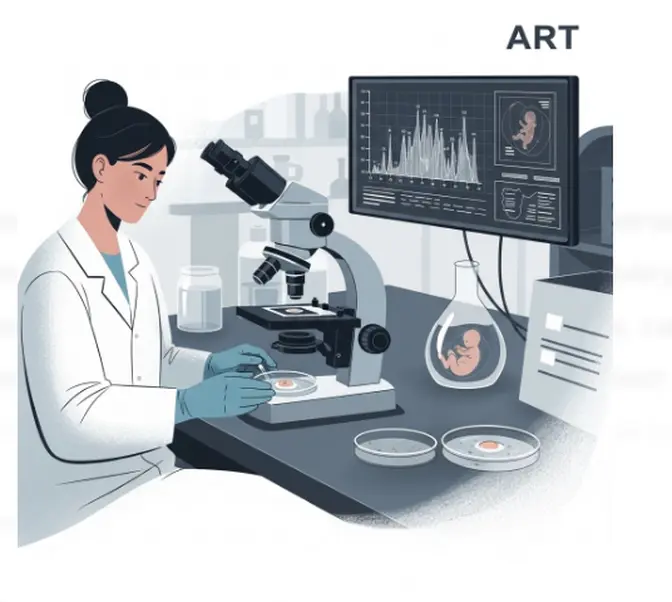The global assisted reproductive technology market was valued at USD 21.32 billion in 2018 and is expected to reach USD 45.06 billion by 2026, growing at a CAGR of 9.8%. The U.S. is experiencing significant market growth, driven by rising infertility rates, advancements in medical technologies, and increased awareness of reproductive treatments. In 2018, Europe led the global market with a share of 41.18%.
The assisted reproductive technology (ART) market refers to a broad range of medical procedures used to address infertility and support conception. These technologies include in vitro fertilization (IVF), intracytoplasmic sperm injection (ICSI), cryopreservation, and fertility medication, among others. The market is driven by factors such as rising infertility rates, delayed pregnancies, lifestyle changes, and increased awareness of available fertility treatments. Advances in technology, improved success rates, and expanding access to fertility clinics are further contributing to market growth. As social acceptance of ART increases and more individuals and couples seek fertility solutions, the assisted reproductive technology market is expected to grow steadily, offering new opportunities for innovation and improved patient outcomes.
Tariff Impact Analysis for Assisted Reproductive Technology Market:
Assisted Reproductive Technology Market Trends:
The rising prevalence of infertility in countries like China, the U.S., the U.K., and India is significantly fueling the demand for assisted reproductive technologies (ART). In 2018, around 6.7% of women aged 15–44 in the U.S. faced infertility, with male infertility also becoming increasingly common. Key contributing factors include sedentary lifestyles, elevated stress levels, and obesity. In response, governments and non-profit organizations across both developed and developing regions are actively working to improve the accessibility and affordability of fertility treatments, further accelerating market growth.
Assisted Reproductive Technology Market Segmentation:
- By Technology:
In Vitro Fertilization (IVF): Most widely used technique in the assisted reproductive technology market.
Intracytoplasmic Sperm Injection (ICSI): Often used in cases of severe male infertility.
Artificial Insemination: Includes intrauterine insemination (IUI) as a common approach.
Surrogacy and Donor Programs: Growing segment for patients with specific medical needs.
- By Procedure Type:
Fresh Embryo Transfer: Utilized in many standard ART cycles.
Frozen Embryo Transfer (FET): Increasingly adopted due to higher success rates and flexibility.
- By End User:
Fertility Clinics: Primary settings for ART procedures with specialized equipment and expertise.
Hospitals: Offer ART services as part of advanced reproductive health departments.
Research Institutes: Involved in developing and testing new ART methods and protocols.

List Of Top Assisted Reproductive Technology Market Companies:
- Bloom IVF Centre
- California Cryobank
- CARE Fertility
- Monash IVF Group
- Carolinas Fertility Institute
- European Sperm Bank
- INVO Bioscience
- Apollo Hospitals Enterprise Ltd.
- Other Players
Market Growth
The assisted reproductive technology market is experiencing consistent growth driven by the increasing prevalence of infertility across both men and women.
Delayed parenthood due to lifestyle choices, career priorities, and late marriages is fueling the demand for ART procedures.
Rising awareness about fertility options and expanding access to specialized fertility clinics are contributing to the growth of the assisted reproductive technology market.
Technological advancements such as improved embryo freezing, genetic screening, and AI-driven embryo selection are enhancing success rates.
The market is expected to witness further expansion as more couples turn to ART for family planning and infertility treatments.
Restraining Factors
High cost of ART treatments can limit access for many individuals, especially in low-income regions.
Emotional, physical, and psychological stress associated with fertility treatments may discourage patients.
Limited insurance coverage or lack of reimbursement for ART procedures acts as a barrier in several regions.
Regulatory and ethical concerns around surrogacy and embryo manipulation can restrict the growth of the assisted reproductive technology market.
Variability in success rates may impact patient trust and overall adoption of ART solutions.
Assisted Reproductive Technology Market Regional Analysis
North America: Leads the assisted reproductive technology market due to high adoption of IVF and strong presence of fertility clinics.
Europe: Witnesses robust growth supported by favorable reimbursement policies and advanced research in reproductive medicine.
Asia-Pacific: Fastest-growing region due to increasing infertility cases, improving healthcare infrastructure, and rising medical tourism.
Latin America & Middle East and Africa: Emerging markets with growing awareness and gradual expansion of fertility services.
Contact Us:
Fortune Business Insights™ Pvt. Ltd.
9th Floor, Icon Tower,
Baner - Mahalunge Road,
Baner, Pune-411045, Maharashtra, India.
Phone: U.S.: +1 424 253 0390
U.K.: +44 2071 939123
APAC: +91 744 740 1245
Email: [email protected]